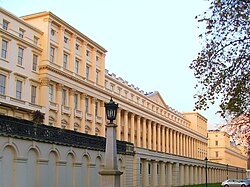
Back کارلتون هاوس تریس Persian Carlton House Terrace French カールトン・ハウス・テラス Japanese Carlton House Terrace Dutch Carlton House#Carlton House Terrace Portuguese Карлтон Хаус Тераса Serbian 卡尔顿府联排 Chinese
| Carlton House Terrace | |
|---|---|
 Nos. 1-9 Carlton House Terrace, facing St James's Park | |
| Location | Whitehall, London |
| Coordinates | 51°30′21″N 0°07′58″W / 51.5058°N 0.1327°W |
| OS grid reference | TQ296801 |
| Built | 1827-29 |
| Architect | John Nash with James Pennethorne, Decimus Burton and others |
| Architectural style(s) | Neoclassical |
| Owner | Crown Estate |
Listed Building – Grade I | |
| Official name | Numbers 1-9 including railings to north and east |
| Designated | 9 January 1970 |
| Reference no. | 1209780 |
Listed Building – Grade I | |
| Official name | Numbers 10 to 18 (including the Institute of Contemporary Arts) and railings to north and west |
| Designated | 9 January 1970 |
| Reference no. | 1209794 |
Listed Building – Grade II* | |
| Official name | 1, Carlton Gardens, London, SW1 |
| Designated | 9 January 1970 |
| Reference no. | 1357247 |
Listed Building – Grade II* | |
| Official name | 2, Carlton Gardens, London, SW1 |
| Designated | 9 January 1970 |
| Reference no. | 1209730 |
Listed Building – Grade II* | |
| Official name | 3, Carlton Gardens, London, SW1 |
| Designated | 9 January 1970 |
| Reference no. | 1066349 |
Carlton House Terrace is a street in the St James's district of the City of Westminster in London. Its principal architectural feature is a pair of terraces, the Western and Eastern terraces, of white stucco-faced houses on the south side of the street, which overlook The Mall and St. James's Park. These terraces were built on Crown land between 1827 and 1832 to overall designs by John Nash, but with detailed input by other architects including Decimus Burton. Construction was overseen by James Pennethorne. Both terrace blocks are Grade I listed buildings. A separate but linked cul de sac at the terrrace's western end is named Carlton Gardens.
In the early 18th century, a townhouse built on the site was rented by Baron Carleton, from whom the present name of the terrace derives. A century later, Carlton House gained a prominent social profile when it was occupied by the Prince Regent. After falling out of favour with George IV, who moved into Buckingham Palace on his accession in 1820, the house was pulled down. The current terraces replaced the demolished palace. They are divided by the Duke of York's Steps which lead down from Pall Mall to The Mall, as part of Nash's triumphal redesign of central London. A smaller flight of steps at the terrace's western end divides it from Carlton Gardens. These steps are the site of the King George VI and Queen Elizabeth Memorial.
The site's proximity to the centres of royal and political life in London have seen a large number of notable people take up residence in the terrace and the adjacent gardens. These include Prime Ministers, Lords Palmerston and Grey, William Gladstone, who lived in a number of houses in both the terrace and the gardens, and Arthur Balfour; other senior politicians such as Lord Curzon; and soldiers including Lords Cardigan and Kitchener. In the mid-20th century, Number 9 served as the German Embassy while Number 4 Carlton Gardens housed the offices of Charles de Gaulle's Free French forces. The terrace is a centre for the arts and sciences, housing the headquarters of the British Academy, the Royal Society, the Royal Academy of Engineering, the Institute of Contemporary Arts and the Federation of British Artists. In the 21st century the majority of the houses are occupied as corporate or institutional headquarters, while a smaller, but increasing, number serve as private homes. For many years Numbers 13-16 housed the headquarters of the Crown Estate which continues to own the freehold of the terrace.
© MMXXIII Rich X Search. We shall prevail. All rights reserved. Rich X Search
